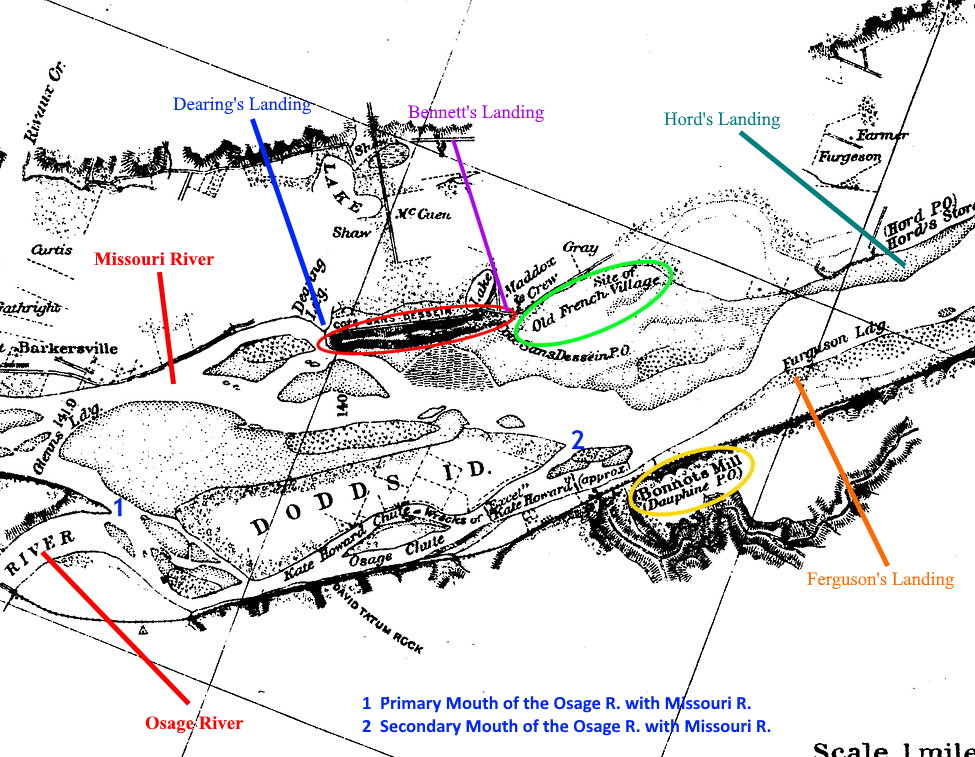
|
Steamboat Information - Steamboats, Captains/Operators & Owners
 |
Anson G. Bennett |

Cote sans Dessein Region on the Missouri River
We know little about the origins of Anson G. Bennett; but the Hartford Times newspaper when reporting his death indicated that Bennett was born in 1797 and died at Cote sans Dessein September 12, 1846 at the age of 49. He married Mollie Anne Moore in Callaway County, April 14, 1825 and the young couple settled at Cote sans Dessein.
Bennett first appears on the official record as Postmaster at Cote sans Dessein January 01, 1828 until the post office at Cote sans Dessein was discontinued June 09, 1829. At this point we lose track of Bennett until a brief newspaper item appeared in the New York Evening Post, July 09, 1833 regarding "Captain A.G. Bennett, master of the steamboat Yellowstone, returning from a trip up the Missouri River bringing a rich cargo of skins of various kinds for the American Fur Company. The Yellowstone ascended the Missouri to the mouth of the river from which she derives her name." On the Yellowstone's second trip up the Missouri in the summer of 1833 cholera broke out on board and by the time the steamboat reached the Kansas River, so many of the crew were dead including the pilot, engineer and all the firemen that Captain Bennett had to put ashore. Bennett left for St. Louis to engage another crew leaving a young clerk named Joseph LaBarge in command. LaBarge, on previous voyages on different steamers, made the most of his opportunities to learn how to handle a steamboat.
When the Missouri settlers heard that cholera was rampant on the Yellowstone, they proceeded to the river to burn the boat unless LaBarge moved it. He became a one-man crew-fireman, engineer, pilot. He got up steam and single-handedly piloted the Yellowstone far enough upstream to be free from the threats of the Missourians. Eventually Captain Bennett returned with a new crew and proceeded to finish the trip. With his reputation as a pilot established, LaBarge he could command almost any steamboat he wanted. LaBarge eventually became the most respected steamboat pilot, owner and line owner of all of the captains of the Missouri River.
On the 1833 trip, German naturalist Maximilian zu Wied-Neuwied, together with Swiss artist Karl Bodmer traveled the Missouri River on board the Yellowstone. Prince Maximilian's diary relating the details of his trip up the Missouri River leaves little doubt as to the state of activity along the river. Bodmer's paintings, along with those of George Catlin, who had traveled upriver on the Yellowstone on an earlier trip, remain as the most accurate depictions of life among the native Americans available. In 1836, the Yellowstone would play a pivotal role in Texas battle for independence. From here we hear little of Bennett until February 26, 1838, when the post office was reestablished at Cote sans Dessein with Bennett reappointed as postmaster. There he remained and operated the post office and a steamboat landing at the east end of the hill at Cote sans Dessein, named Bennett's Landing, until his death in 1846. His name is still associated with that landing in the minds of residents of the area. Only the memory and the rocky prominence nearby remains of the once busy village of Cote sans Dessein twelve miles downriver on the north bank of the Missouri near its confluence with the Osage River.
Bennett has been widely attributed with many unscrupulous actions while piloting on the Missouri River. The most widely circulated was his propensity to carry large quantities of whisky, disguised in wooden crates, onboard his steamers for sale to the Indians in the upper reaches of the Missouri River. When his steamer was stopped at Fort Leavenworth and about to be boarded and searched for contraband, he commanded several of his deck hands "to take those dead bodies off the ship", explaining to the inspectors that there were several deaths aboard due to cholera. He was immediately ordered to keep the bodies onboard and proceed. In another incident in which he was boarded for inspection, the inspectors found a number of strange parts among the cargo, which were seemingly out of place. When asked about these items, Bennett explained that they were important parts for maintenance of the steamboat boiler, when, in actuality, they were the disassembled parts of a still, which would be used for the production of alcohol further upriver.
From the trips of Bennett on the Yellowstone and his later trips up the Missouri River, we see the heroic actions of several associated persons come forward among the baser motives of Bennett, the American Fur Company and Chouteau family. Bennett returned to his beloved Cote sans Dessein and, by appearances, led a very settled life. We must assume that his reputation among the rivermen of the time contributed to his success at Bennett's Landing.